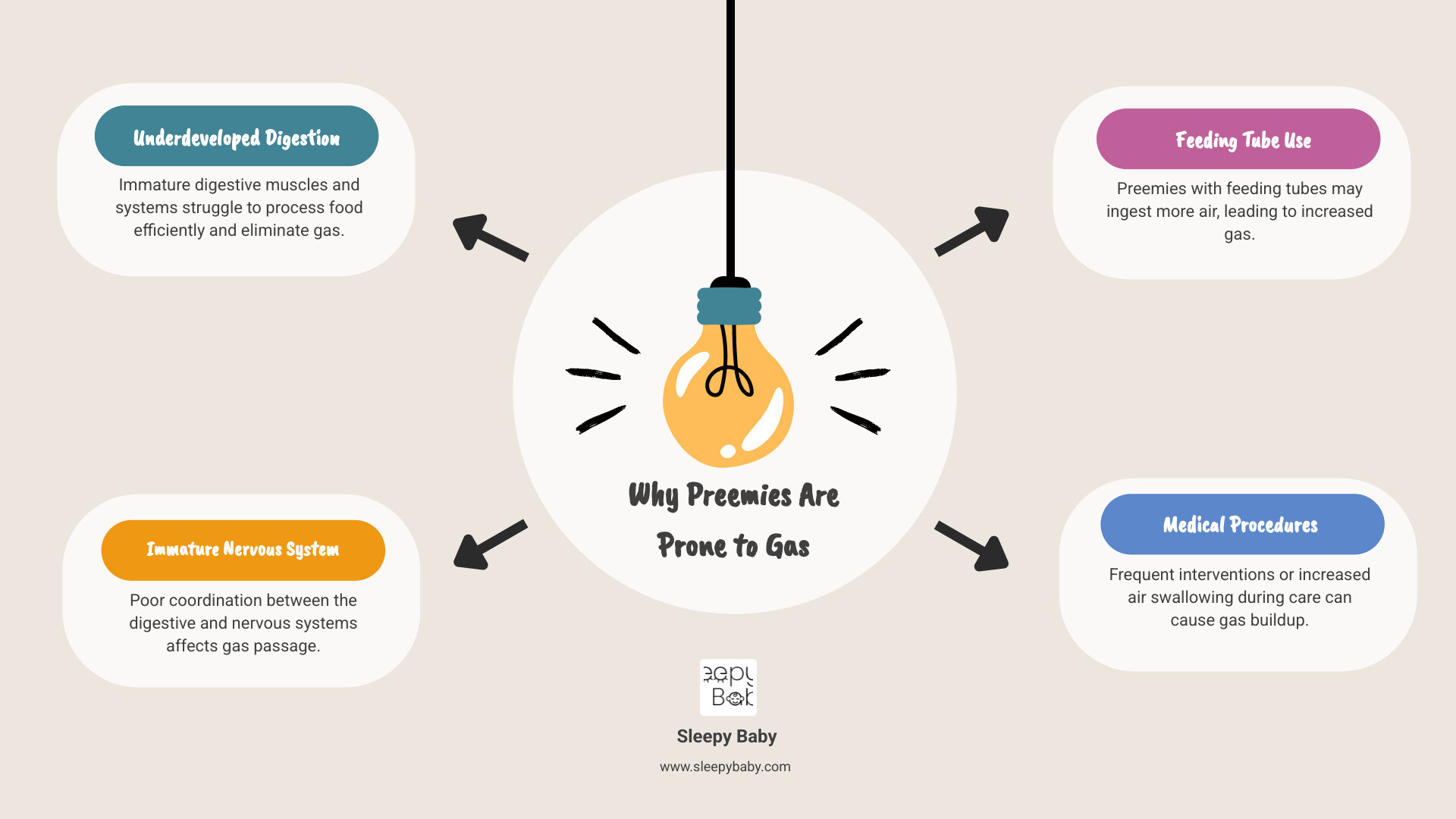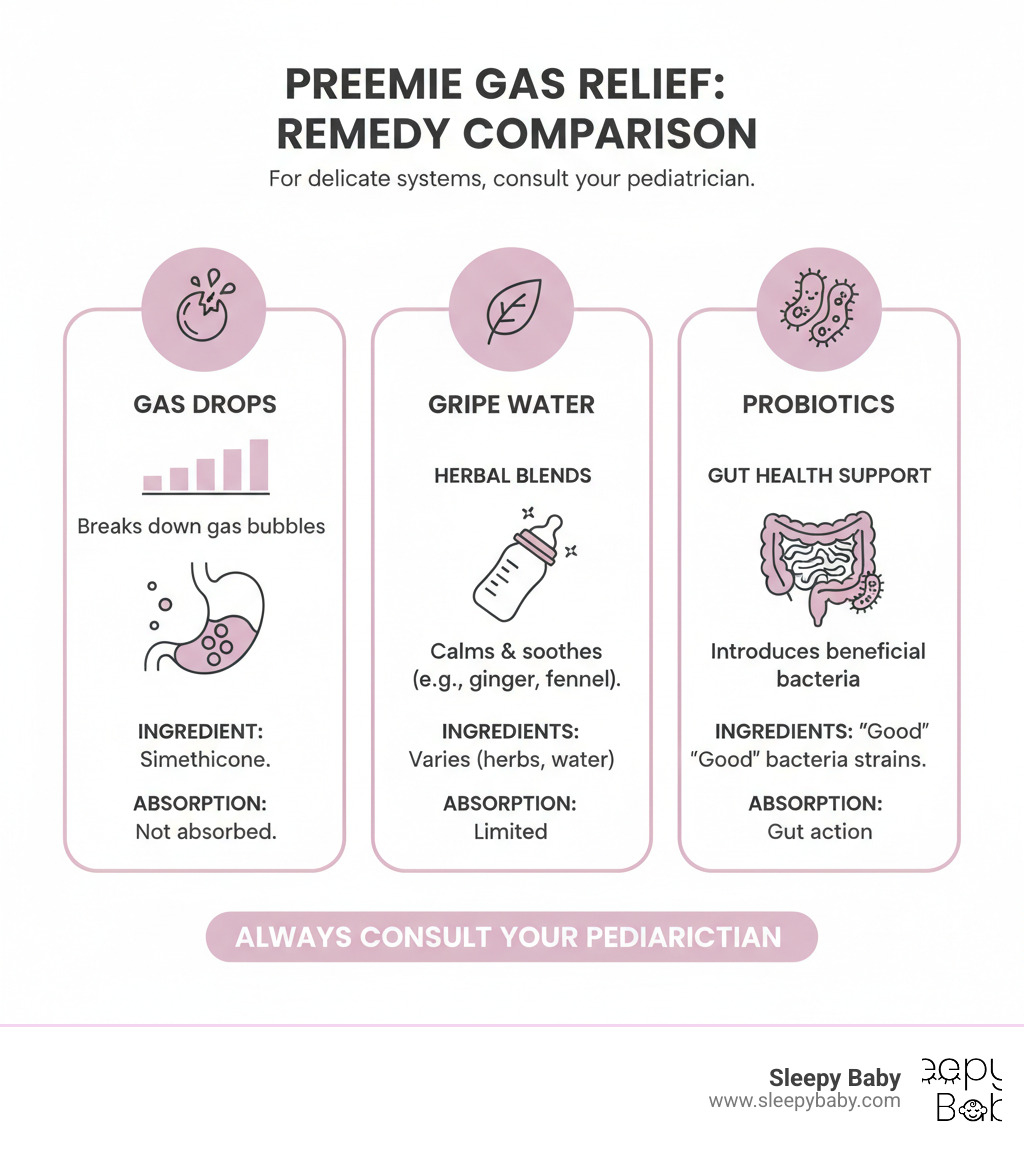Understanding Gas Relief Options for Your Premature Baby
Gas drops for preemies are generally considered safe when used under pediatric guidance, but premature babies require special considerations due to their underdeveloped digestive systems and unique medical needs.
Quick Safety Guide for Gas Drops and Preemies:
- Active Ingredient: Simethicone (20mg doses) - breaks up gas bubbles safely
- Safety: Generally safe for preemies, but always consult your NICU team or pediatrician first
- Dosage: Use weight-based dosing, not age - typically 0.3mL for babies under 24 lbs
- Frequency: Up to 12 times daily if needed, best used preventatively at feeding time
- Brands: Mylicon and Little Remedies are pediatrician-recommended options
- When to Avoid: If baby takes thyroid medications or has specific NICU restrictions
Premature babies face unique challenges that full-term infants don't experience. Their digestive systems are still developing, making them more prone to gas, bloating, and feeding difficulties. The muscles needed for proper digestion and gas elimination are weaker, and their nervous systems haven't fully matured to coordinate these bodily functions effectively.
This combination creates a perfect storm for uncomfortable gas buildup. While gas is normal for all babies, preemies often struggle more with trapped air from feeding tubes, frequent medical procedures, or simply from their immature digestive processes.
As a father who steerd the overwhelming early days with my own child, I understand the desperation parents feel when searching for safe relief options. My experience developing solutions for infant comfort, combined with extensive research into gas drops for preemies, has taught me that informed decisions always start with understanding both the benefits and limitations of each approach. The key is working closely with your medical team to find what works best for your unique little one.

Relevant articles related to gas drops for preemies:
Is It Gas? Recognizing the Signs of Discomfort in Your Preemie
Watching your precious preemie writhe and cry is one of the most heart-wrenching experiences as a parent. You want so desperately to help, but first you need to figure out what's wrong. Is it hunger? A dirty diaper? Or could it be gas causing all that discomfort?

For preemies, gas discomfort can be particularly intense due to their underdeveloped digestive systems. Learning to recognize the signs can help you determine when gas drops for preemies might be appropriate - and when it's time to call your pediatrician.
Fussiness after feeding is often the first clue. If your little one seems content during their meal but becomes increasingly agitated within an hour afterward, trapped gas could be the culprit. You might notice them pulling their legs to chest in what looks like a tiny yoga pose - this instinctive movement helps babies try to relieve abdominal pressure.
A hard, bloated tummy is another telltale sign. When you gently touch your baby's belly, it may feel firm or distended rather than soft. This physical symptom often accompanies excessive crying that seems different from their usual hunger or tired cries. As pediatrician Amy Sniderman, MD, points out, "A baby who's showing discomfort because of gas is asking for some help from their caretakers."
You might also observe squirming and arching back as your preemie tries to find a comfortable position. These movements, combined with straining or grunting sounds, often indicate they're struggling to pass gas or have a bowel movement.
It's important to distinguish gas discomfort from colic, though the two can overlap. Colic involves crying for more than three hours a day, more than three days a week, for three weeks or longer - often without an obvious cause. While research shows that simethicone (the active ingredient in gas drops) isn't particularly effective for true colic, it can still provide relief when gas is clearly the problem.
For a deeper understanding of colic symptoms and how they differ from gas discomfort, check out our guide on The Crying Game: Recognizing Colic Symptoms in Babies.
You know your baby best. Trust your instincts when something seems off, and don't hesitate to reach out to your medical team for guidance.
A Guide to Gas Drops for Preemies
When your precious preemie is struggling with gas pain, it's natural to want immediate relief for them. Gas drops for preemies have become a go-to solution for many parents, but understanding how they work can help you use them more effectively.
The active ingredient in most infant gas drops is simethicone. It isn't a pain medication or a digestive aid—it's more like a bubble-popping helper.
Think of your baby's tummy filled with tiny, foamy bubbles that get stuck and cause pressure. That's essentially what trapped gas looks like. Simethicone works by reducing the surface tension of these gas bubbles, causing the small, troublesome bubbles to merge into bigger ones. These larger bubbles are much easier for your little one to burp up or pass naturally.
What makes simethicone particularly appealing for gas drops for preemies is that it doesn't get absorbed into your baby's bloodstream. It simply does its bubble-combining work in the digestive tract and then passes right through. This local action is why many pediatricians feel comfortable recommending it even for the tiniest patients.
Many experts, including Dr. Lauren Crosby from the American Academy of Pediatrics, suggest a proactive approach. Dr. Alexis Philips from Memorial Hermann Medical Group Pediatrics recommends giving gas drops at feeding time—about four times a day—to prevent gas buildup before it becomes painful.
For a deeper dive into exactly how simethicone provides relief, you might find our article helpful: How Does Simethicone Work? The Science Behind Gas Relief.
Are gas drops for preemies a safe choice?
The key question every preemie parent asks is: "Is this safe for my tiny baby?" This concern is understandable—when a baby arrives early, every decision feels magnified.
The reassuring news is that simethicone has an excellent safety profile. It's FDA approved for infant use and has been helping gassy babies for decades. Dr. Alexis Philips affirms that simethicone is generally safe for babies because it's not absorbed into the bloodstream.
However, and this is crucial for preemie parents, "generally safe" doesn't mean you should skip consulting your medical team. Your NICU staff or pediatrician knows your baby's unique medical history, medications, and specific needs. This consultation is even more important if your preemie is in the NICU or recently discharged, as their delicate systems require extra consideration.
Most NICU practices are familiar with simethicone use and have protocols for its administration. Experienced NICU professionals have seen countless preemies and understand which interventions are most helpful.
While side effects are uncommon, some babies might experience loose stools. More importantly, there's a potential interaction with thyroid medications. If your preemie takes thyroid hormone medication, gas drops should generally be avoided unless your doctor specifically approves them, as simethicone can interfere with thyroid hormone absorption.
Regarding long-term effects, the news is positive. Since simethicone isn't absorbed, there's no evidence suggesting any lasting consequences from its use. As the Mayo Clinic notes, "in general, there's no harm in giving your baby gas drops if they seem to help."
For a comprehensive look at simethicone's safety profile, check out: Is Simethicone Safe? Understanding Potential Side Effects.
Recommended dosage and brands of gas drops for preemies
Once your pediatrician approves gas drops for preemies, you'll need to steer dosage and brand selection, which can feel overwhelming when you're exhausted.

Dosage is absolutely critical for preemies. While product labels often give age-based dosing, weight-based dosing is essential for premature infants and must be confirmed by your pediatrician. The standard dose is typically 20 milligrams of simethicone. Most infant gas drops come with a dropper that measures 0.3 mL, which usually corresponds to this 20mg dose for babies under 24 pounds.
Dr. Alexis Philips notes that this dose can be given up to four times daily, or even up to 12 times per day if necessary. Always use the enclosed syringe or dropper that comes with your chosen product for accuracy.
When it comes to trusted brands, Mylicon and Little Remedies consistently rise to the top of pediatricians' recommendations. Mylicon is often called the "#1 pediatrician-recommended brand" and offers dye-free formulas free from saccharin, alcohol, artificial flavors, and gluten.
Little Remedies is another parent favorite, with dye-free, gluten-free drops that are also free from alcohol, parabens, and artificial flavors. They often come in a natural berry flavor.
For preemies especially, choosing dye-free formulas and carefully reading ingredient lists is vital. You'll want to avoid additives like alcohol, saccharin, artificial flavors, or parabens. The Mayo Clinic also suggests steering clear of drops containing sodium benzoate or benzoic acid when possible. Simpler ingredients mean less potential for sensitivity.
Your pediatrician remains your best resource for determining the perfect dosage and brand for your specific preemie.
For more detailed guidance on selecting the right gas drops, explore our comprehensive guide: Step-by-Step Guide to Choosing Effective Infant Gas Drops.
Gas Drops vs. Other Remedies: A Comparison for Preemie Parents
When your precious preemie is struggling with gas, you'll likely encounter advice about various remedies beyond gas drops for preemies. From well-meaning relatives suggesting gripe water to online forums discussing probiotics, the options can feel overwhelming. Let's break down how these remedies compare, so you can have informed discussions with your pediatrician.

The reality is that each remedy works differently, and what's safe for a full-term baby might not be the best choice for your preemie. Understanding these differences can help you make the safest, most effective choice for your little one's comfort.
Gas Drops vs. Gripe Water
This comparison comes up constantly in parenting groups, and for good reason – both products promise relief from infant discomfort, but they couldn't be more different in their approach.
Gas drops containing simethicone work like a targeted tool. They break down gas bubbles physically, making them easier for your baby to pass. The ingredient isn't absorbed into your baby's system, which is why pediatricians often feel comfortable recommending them. Think of simethicone as a gentle bubble-popper that works right in the digestive tract.
Gripe water takes a completely different approach. It's typically a blend of water, sodium bicarbonate, and various herbal ingredients like ginger, fennel, chamomile, or dill seed oil. The theory is that these herbs soothe the digestive system while sodium bicarbonate neutralizes stomach acid. It sounds gentle and natural, which appeals to many parents.
However, here's where things get tricky for preemies. While simethicone is FDA-approved with well-understood effects, gripe water falls into the alternative medicine category and isn't regulated by the FDA. Dr. Amy Sniderman of Cleveland Clinic generally doesn't recommend gripe water due to limited scientific evidence supporting its effectiveness.
For premature babies specifically, gripe water presents additional concerns. The multiple herbal ingredients increase the risk of allergic reactions or sensitivities – something preemies are already more prone to. Some formulations have been associated with bacterial contamination or alkalosis from excessive sodium bicarbonate, risks that are particularly concerning for babies with developing immune systems.
If your preemie shows classic gas signs like a hard, bloated tummy or pulling legs to chest, gas drops for preemies offer a more direct, evidence-based approach. For a detailed comparison of these options, check out our article: Baby Gas Drops and Gripe Water Face-Off: Which Wins for Colic Relief?.
The Role of Probiotics
Probiotics represent yet another approach entirely – instead of addressing immediate symptoms, they focus on long-term gut health by introducing "good" bacteria to support a healthy microbiome.
For preemies, this concept is particularly intriguing. Premature babies often have disrupted gut bacteria due to early birth, antibiotic treatments, or extended hospital stays. The idea of restoring balance with probiotics makes intuitive sense to many parents.
The research on probiotics for infant gas and colic shows mixed results, though some studies suggest certain strains might help reduce crying time in colicky, breastfed babies. The Mayo Clinic notes that while some new research indicates probiotics could be helpful for infant colic, other studies have shown mixed results, so more research is needed.
Here's the key difference: while gas drops for preemies work immediately to break up existing gas bubbles, probiotics are more of a long-term gut health strategy. They're not typically recommended for general fussiness, and for preemies, the decision becomes even more complex.
Your pediatrician will consider your baby's specific health situation, including any medications, feeding methods, and overall development before recommending probiotics. Some preemies may benefit from specific strains at certain times, while others might not need them at all.
The bottom line? Probiotics aren't a quick fix like gas drops, but they might play a role in your preemie's overall digestive health journey. Always discuss this option with your medical team rather than starting them on your own.
For a deeper dive into how gas drops and probiotics compare, read our article: Battle of the Baby Bellies: Gas Drops and Probiotics Go Head to Head.
Gentle, Non-Medicinal Ways to Soothe Your Gassy Preemie
Sometimes the gentlest approach is most effective. While gas drops for preemies can provide relief, many parents find that simple, time-tested techniques work wonders. These methods help prevent gas buildup and allow trapped air to pass naturally.

Feeding adjustments can make a remarkable difference. Try keeping your baby in an upright feeding position with their head slightly higher than their stomach. This lets gravity keep air bubbles at the top where they're easier to burp up.
If you're bottle-feeding, consider bottles with vented systems or angled designs that reduce air intake. Slow-flow nipples give your preemie more control over milk flow, preventing them from gulping and swallowing excess air. A pro tip: stir formula gently instead of shaking it vigorously to avoid creating extra bubbles.
Frequent burping is even more important with preemies. Pause regularly during feedings to help your baby release trapped air. Some babies need burping every half-ounce. Try different positions: over your shoulder, sitting upright on your lap, or lying face-down across your forearm.
Tummy time serves double duty. Besides strengthening developing muscles, the gentle pressure on their belly can help move gas along. Always supervise these sessions, and keep them short and sweet.
A warm bath works like magic for many fussy babies. The soothing warmth helps relax abdominal muscles and provides overall comfort. A warm washcloth placed gently on the tummy can also bring relief.
Gentle stomach massage and leg movements create a powerful one-two punch against gas. Lightly rub your baby's belly in clockwise circles. Then try the classic "bicycle" motion with their legs—gently bringing knees toward the chest and cycling them. Many babies pass gas almost immediately with this technique.
The American Academy of Pediatrics advice on breaking up gas emphasizes these natural methods as first-line approaches.
The Power of Rhythmic Soothing
When your preemie is still fussy, rhythmic soothing can be your secret weapon. Consistent, gentle motions can be magical, reminding babies of the womb.
Rhythmic patting provides the steady, comforting touch that babies crave. This familiar sensation helps calm their developing nervous system and can distract from the discomfort of trapped gas. The key is consistency—gentle, rhythmic taps that create a soothing pattern.
White noise adds another layer of comfort by blocking jarring sounds and providing a steady hum reminiscent of life before birth. While some older white noise machines raised safety concerns about volume, modern safety-rated devices present white noise at low-decibel levels that protect sensitive hearing. Some innovative options even apply sound therapy directly to your baby's chest for more targeted comfort.
This is where technology meets tender care. Rhythmic tapping devices offer hands-free support for exhausted caregivers while providing consistent comfort. These devices can be game-changers for a gassy preemie who needs constant soothing—they never get tired and provide the exact rhythmic comfort your baby craves.
At Sleepy Baby, we understand parents sometimes need extra support. Our intelligent sleep aids combine gentle rhythmic patting with safe white noise levels, mimicking a caregiver's touch while giving you moments to rest.
Understanding your preemie's unique sleep needs can improve all your soothing efforts. Learn more about Preemie Sleep Patterns: What the Experts Say to create the most effective comfort routine.
Frequently Asked Questions about Gas Relief for Preemies
As parents of premature babies, you're likely juggling countless concerns while learning to care for your little one. Gas relief questions come up frequently, and we want to give you the clear, reassuring answers you need to feel confident in your decisions.
How long do gas drops take to work for a preemie?
When your tiny preemie is squirming and crying from gas pain, waiting for relief can feel like forever. The good news is that gas drops for preemies typically begin working within up to 30 minutes, though this can vary from baby to baby. Some parents notice their little one settling down sooner, while others find it takes the full half-hour to see improvement.
Here's something many parents don't realize: gas drops work most effectively when used preventatively rather than reactively. Instead of waiting until your baby is already uncomfortable, many pediatricians recommend giving the drops before feedings. This proactive approach helps break up gas bubbles as they form, potentially leading to faster and more consistent relief for your preemie.
Can I give my preemie gas drops at every feeding?
This is one of the most common questions we hear from worried parents. The reassuring answer is that gas drops for preemies containing simethicone are generally safe for frequent use. Pediatrician Alexis Philips, DO, notes that gas drops can be used up to 12 times a day if necessary, and she specifically advises giving them at feeding time for the best results.
The Mayo Clinic supports this frequency, stating that the typical 20-milligram dose of simethicone can be given up to four times daily and is safe for everyday use. However, "safe" doesn't automatically mean "necessary" for your particular baby.
Always follow your pediatrician's guidance rather than just the product packaging. For preemies, your doctor might recommend a different schedule based on your baby's individual needs, weight, and overall health status. The goal is providing comfort, not over-medicating your little one.
When should I call the doctor about my preemie's gas?
While gas is completely normal for all babies, especially preemies with their developing digestive systems, certain warning signs mean it's time to pick up the phone and call your pediatrician immediately.
Trust your parental instincts first - if something feels different or wrong, don't hesitate to seek medical advice. You should contact your baby's healthcare provider right away if your preemie's gas symptoms come with fever, vomiting (especially if it's forceful or greenish), blood in stool, or refusal to eat. Any fever in a young infant, particularly a preemie, needs prompt medical evaluation.
Inconsolable or unusual crying is another red flag. The Mayo Clinic advises seeking immediate medical care for "prolonged or excessive crying that is different than usual." As Dr. Amy Sniderman points out, if gas is "interrupting your baby's ability to have a bowel movement, or if it's interfering with their feeding or sleep," it's definitely time to consult your pediatrician.
Other concerning signs include signs of allergic reactions like hives or difficulty breathing, or if the gas issues seem to be impacting your baby's weight gain. Your pediatrician is your most valuable partner in your preemie's health journey, so never feel like you're bothering them with concerns.
For additional expert guidance on infant discomfort and colic, the Mayo Clinic offers comprehensive resources to help you understand when professional medical attention is needed.
Conclusion: Partnering with Your Pediatrician for a Happy Tummy
Caring for a premature baby has unique challenges, and gas discomfort is often one. We've explored how gas drops for preemies offer relief via simethicone's gentle action, while emphasizing that your pediatrician's guidance is irreplaceable.
Gas drops for preemies are generally safe when used appropriately, but every preemie is different. What works for one baby might need adjustment for another. Your NICU team or pediatrician understands your baby's specific medical history and needs better than anyone.
We've also found that gas relief isn't just about medication. The most effective approach often combines gentle techniques like bicycle leg movements, proper feeding positions, and soothing rhythmic comfort with medical interventions. Modern sleep aids that provide safe white noise and rhythmic patting can be particularly helpful for sensitive preemies who need extra comfort.
The comparison of gas drops, gripe water, and probiotics shows that evidence-based approaches are often best for vulnerable babies. While other remedies exist, the proven safety of simethicone makes gas drops for preemies a reliable first choice for many pediatricians.
Your instincts as a parent matter. Trust yourself when something doesn't feel right, and don't hesitate to reach out to your medical team. Whether it's adjusting dosages or exploring complementary soothing techniques, your pediatrician is there to help you find the right combination of solutions.
Every step toward your preemie's comfort is a victory. With patience, informed choices, and the right medical partnership, you can help your little one achieve the peaceful, comfortable tummy they deserve. For additional insights into choosing the best products for your baby's needs, explore our comprehensive guide: Relief in a Drop: Top Infant Gas Drops Reviewed.



